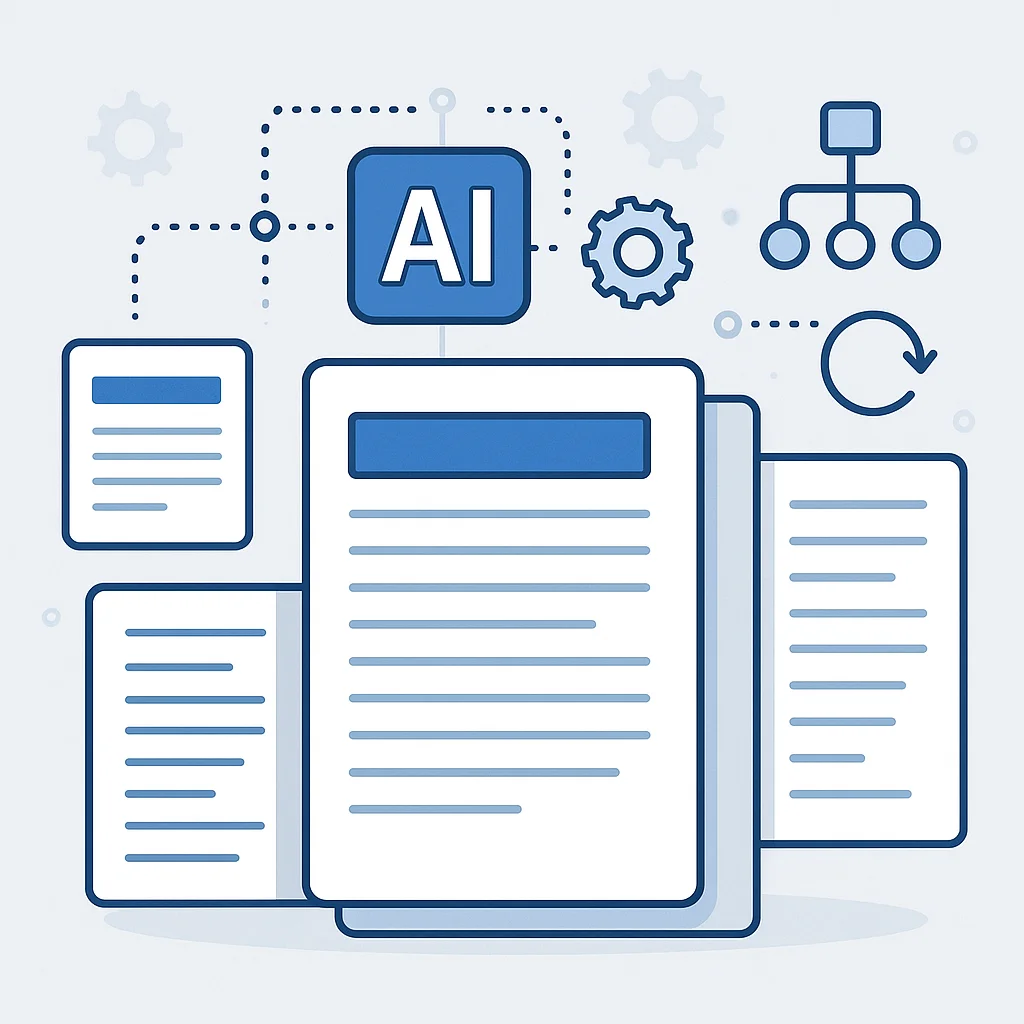Now Reading: 7 Powerful AI Business Automation Strategies for Maximum ROI
-
01
7 Powerful AI Business Automation Strategies for Maximum ROI
7 Powerful AI Business Automation Strategies for Maximum ROI

The business landscape is more competitive than ever, and companies that still rely on manual processes are getting left behind. I’ve seen it happen time and again. The good news? AI business automation strategies offer a powerful solution to this challenge. By strategically implementing AI tools to handle repetitive tasks, businesses can redirect human talent toward innovation and growth. In this guide, I’ll walk you through proven approaches that have helped my clients achieve remarkable efficiency gains.
Key Takeaways
What are effective AI business automation strategies?
- Start with high-impact processes – Focus first on automating repetitive tasks that consume significant employee time and have clear rules
- Implement AI-powered customer support – Use chatbots and virtual assistants to handle routine inquiries 24/7
- Automate HR workflows – Streamline candidate screening, interview scheduling, and employee onboarding
- Optimize supply chain management – Use AI to predict demand, manage inventory, and identify inefficiencies
- Enhance finance operations – Automate invoice processing, expense tracking, and fraud detection
- Ensure proper data integration – Connect AI tools with your existing systems to maintain data flow and consistency
- Include human oversight – Maintain human review for complex decisions requiring judgment
Identifying High-Impact Processes For AI Automation
When I first start working with clients on AI business automation strategies, I always tell them the same thing: don’t try to automate everything at once. That’s a recipe for disaster. Instead, you need to identify the processes that will give you the biggest bang for your buck.
The most effective approach is to look for tasks that are:
- Repetitive and time-consuming – These are the low-hanging fruit where automation delivers immediate time savings
- Rule-based with clear parameters – Processes with well-defined steps are easier to automate successfully
- High-volume – The more frequently a task occurs, the greater the cumulative benefit of automation
- Prone to human error – Tasks requiring data entry or calculations often benefit most from automation
- Directly impacting operational efficiency – Focus on processes that create bottlenecks in your workflow
For example, one of my manufacturing clients was spending hours each week manually entering purchase orders into their system. By implementing an AI document processing solution, they reduced processing time by 85% and virtually eliminated data entry errors. The ROI was clear within just two months.
When evaluating potential processes for automation, I recommend creating a simple scoring matrix. Rate each process on factors like time required, frequency, error rates, and strategic importance. This helps prioritize your automation initiatives for maximum impact.
Useful Articles:
Implementing AI-Powered Customer Support
Customer support is one of the most promising areas for AI business automation strategies. I’ve seen companies transform their customer experience while significantly reducing costs through strategic implementation of AI tools.
Chatbots and Virtual Assistants
Modern AI-powered chatbots can handle a surprising range of customer inquiries without human intervention. They excel at:
- Answering frequently asked questions
- Providing product information and recommendations
- Processing simple transactions
- Collecting customer information before escalation
- Offering 24/7 support without staffing costs
One retail client I worked with implemented an AI chatbot that now handles 65% of all customer inquiries completely autonomously. This allowed them to reassign support staff to handle more complex issues that truly required human empathy and problem-solving skills.
Best Practices for Implementation
When implementing AI for customer support, I always emphasize these key points:
- Start with a clear scope – Begin by automating responses to your most common customer questions
- Train your AI with quality data – Feed your system with actual customer conversations and queries
- Create a seamless handoff process – Ensure smooth transitions when issues need human intervention
- Continuously improve – Regularly review conversations where the AI struggled and refine its responses
- Maintain brand voice – Customize your AI’s communication style to match your company’s tone
The most successful implementations I’ve seen take an iterative approach. Don’t try to build the perfect system from day one. Start with handling simple queries, then gradually expand the AI’s capabilities as you gather more data and learn from real interactions.
Automating HR Workflows
HR departments often struggle with numerous repetitive tasks that are perfect candidates for AI automation. I’ve helped several companies transform their HR operations through strategic automation, resulting in faster hiring processes and improved employee experiences.
Recruitment and Hiring
The hiring process contains multiple steps that can benefit from AI automation:
- Resume screening – AI can scan applications to identify qualified candidates based on skills, experience, and education
- Interview scheduling – Automated systems can coordinate availability between candidates and hiring managers
- Initial candidate assessment – AI-powered assessments can evaluate technical skills and job fit
- Onboarding documentation – Automated systems can generate and process new hire paperwork
One tech company I worked with reduced their time-to-hire by 40% by implementing AI resume screening and automated interview scheduling. This not only saved their HR team countless hours but also improved the candidate experience by providing faster responses.
Employee Management
Beyond hiring, AI can streamline ongoing HR processes:
- Performance monitoring – AI systems can track productivity metrics and highlight patterns
- Training recommendations – Based on performance data, AI can suggest relevant development opportunities
- Leave management – Automated approval workflows for time-off requests
- Benefits administration – Self-service portals with AI assistance for employee questions
When implementing HR automation, it’s crucial to maintain the human element where it matters most. For example, while AI can efficiently screen resumes, final hiring decisions should still involve human judgment to assess cultural fit and soft skills that AI might miss.
I always advise my clients to be transparent with employees about how AI is being used in HR processes. This builds trust and reduces resistance to new technologies.
Useful Articles:
Optimizing Supply Chain Management
Supply chain operations present some of the most compelling opportunities for AI business automation strategies. I’ve seen companies achieve remarkable improvements in efficiency and cost reduction through strategic implementation of AI in this area.
Inventory Management
AI excels at optimizing inventory levels by:
- Predicting demand fluctuations based on historical data, seasonal trends, and external factors
- Automating reorder points to maintain optimal stock levels
- Identifying slow-moving inventory that ties up capital
- Detecting potential stockouts before they occur
A retail client I worked with implemented AI-driven inventory management and reduced their carrying costs by 23% while simultaneously decreasing stockouts by 45%. The system continuously learns from sales patterns and adjusts forecasts accordingly.
Supplier Interactions
AI can also streamline interactions with suppliers through:
- Automated purchase order generation based on inventory levels
- Supplier performance tracking to identify reliability issues
- Price optimization through analysis of market conditions
- Contract compliance monitoring to ensure terms are being met
Logistics Optimization
Transportation and logistics benefit tremendously from AI automation:
- Route optimization to reduce fuel costs and delivery times
- Load planning to maximize vehicle utilization
- Delivery time prediction for improved customer communication
- Anomaly detection to identify potential delays early
One manufacturing client reduced their logistics costs by 18% after implementing AI-powered route optimization and load planning. The system continuously adapts to changing conditions like traffic patterns, weather, and delivery priorities.
When implementing supply chain automation, I recommend starting with a specific pain point rather than trying to overhaul the entire operation at once. For example, begin with inventory optimization for your highest-value products, then expand to other areas as you demonstrate success.
The most effective supply chain automation combines AI algorithms with human oversight. While AI can process vast amounts of data and identify patterns, experienced supply chain professionals should review recommendations and make final decisions on critical issues.
Enhancing Finance Operations
Finance departments deal with numerous repetitive, rule-based tasks that are ideal candidates for AI automation. I’ve helped companies transform their financial operations through strategic implementation of AI tools, resulting in significant time savings and improved accuracy.
Invoice Processing and Accounts Payable
Manual invoice processing is notoriously time-consuming and error-prone. AI automation can:
- Extract key information from invoices regardless of format
- Match invoices to purchase orders automatically
- Route approvals based on predefined rules
- Flag exceptions that require human review
- Schedule payments to optimize cash flow
A manufacturing client I worked with reduced their invoice processing time from 14 days to just 2 days after implementing AI automation. This not only improved vendor relationships but also allowed them to capture more early payment discounts.
Expense Management
Employee expenses represent another area ripe for automation:
- Receipt scanning with automatic data extraction
- Policy compliance checking to flag potential violations
- Approval routing based on amount thresholds and departments
- Reimbursement processing with minimal manual intervention
Fraud Detection and Prevention
AI excels at identifying unusual patterns that might indicate fraudulent activity:
- Anomaly detection in transaction patterns
- Duplicate payment identification
- Vendor verification against known fraud databases
- Continuous monitoring of all financial transactions
One financial services client implemented AI fraud detection and identified over $200,000 in potentially fraudulent transactions in the first six months-transactions that would likely have gone undetected with manual reviews alone.
When implementing finance automation, I always emphasize the importance of maintaining proper controls and audit trails. While AI can handle routine processing, you need clear visibility into how decisions are being made and the ability to review automated actions.
Start with a specific finance process that causes the most pain in your organization. For many companies, that’s accounts payable or expense management. Once you’ve successfully automated one area, you can expand to others using the lessons learned from your initial implementation.
Useful Articles:
Ensuring Proper Data Integration
For AI business automation strategies to succeed, proper data integration is absolutely essential. I can’t stress this enough-I’ve seen promising automation initiatives fail simply because the AI tools couldn’t access the right data at the right time.
Connecting Your Systems
Effective AI automation requires:
- API connections between your AI tools and existing business systems
- Data standardization to ensure consistency across platforms
- Real-time data flows to enable timely automated decisions
- Proper access controls to maintain security while enabling functionality
One healthcare client struggled with their initial automation efforts because patient data was siloed across three different systems. Once we implemented proper integration, their AI-powered scheduling system reduced no-shows by 35% by sending personalized reminders based on patient history and preferences.
Data Quality Considerations
The old saying “garbage in, garbage out” is especially true for AI systems. To ensure success:
- Clean existing data before feeding it into AI systems
- Implement validation rules to prevent bad data from entering
- Create data governance policies to maintain quality over time
- Regularly audit data quality to identify and address issues
I always tell my clients that investing in data quality pays dividends across all your automation initiatives. It’s better to spend time getting your data house in order first than to build automation on a shaky foundation.
Integration Best Practices
Based on my experience implementing dozens of AI automation projects:
- Start with a data audit – Understand where your critical data resides and its current quality
- Create a unified data strategy – Develop a plan for how data will flow between systems
- Implement middleware if necessary – Sometimes you need a layer between legacy systems and new AI tools
- Test thoroughly before full deployment – Validate that data flows correctly in all scenarios
- Monitor ongoing performance – Watch for integration issues that could impact automation
Including Human Oversight
While AI business automation strategies can dramatically improve efficiency, I always emphasize to my clients that maintaining appropriate human oversight is crucial. The most successful automation implementations I’ve seen maintain a thoughtful balance between AI efficiency and human judgment.
Designing Effective Human-in-the-Loop Systems
The key is creating systems where:
- AI handles routine decisions based on clear rules and patterns
- Unusual cases are flagged for human review
- Humans can easily override AI decisions when necessary
- The system learns from human interventions to improve over time
For example, a financial services client automated their loan approval process but maintained human review for applications that fell into gray areas. This approach reduced processing time by 70% while still ensuring appropriate risk management.
Approval Checkpoints
I recommend establishing clear approval checkpoints for:
- High-value transactions that exceed certain thresholds
- Unusual patterns that deviate from normal operations
- Customer-facing communications that could impact your brand
- Decisions with regulatory implications where compliance is critical
Training and Transition
Successfully implementing human oversight requires:
- Clear roles and responsibilities for both AI systems and human reviewers
- Training programs to help employees work effectively with AI tools
- Performance metrics that balance efficiency with quality control
- Feedback mechanisms to continuously improve the system
One manufacturing client initially faced resistance when implementing AI quality control. By clearly defining how humans would oversee the AI system and involving operators in the design process, they achieved both buy-in and a more effective solution.
The goal isn’t to have humans checking every AI decision-that would defeat the purpose of automation. Instead, design systems where humans focus their attention where it adds the most value: on complex edge cases, strategic decisions, and situations requiring empathy or creativity.
AI business automation strategies represent a powerful opportunity to transform how your business operates. By focusing on high-impact processes, ensuring proper integration, and maintaining human oversight, you can achieve significant improvements in efficiency, accuracy, and customer satisfaction.





















